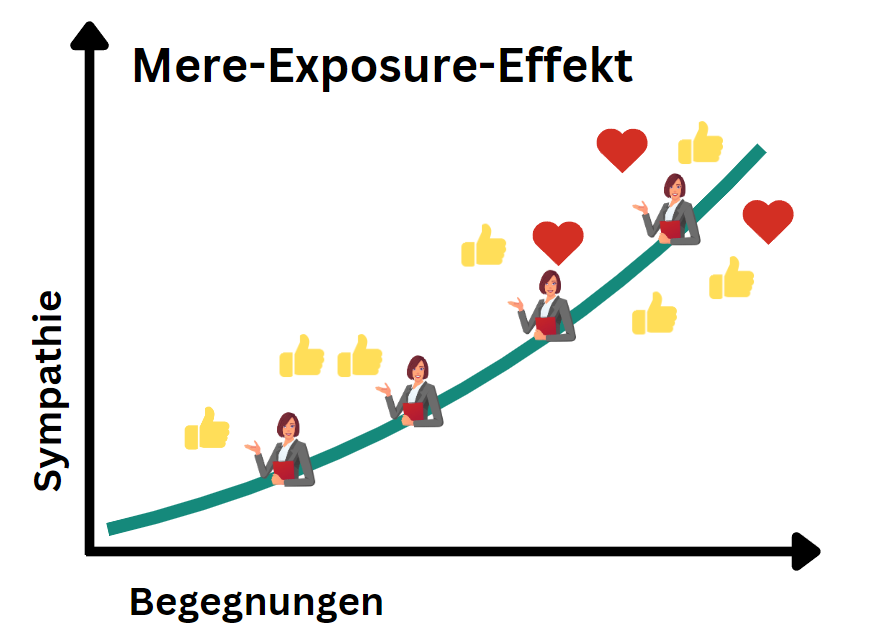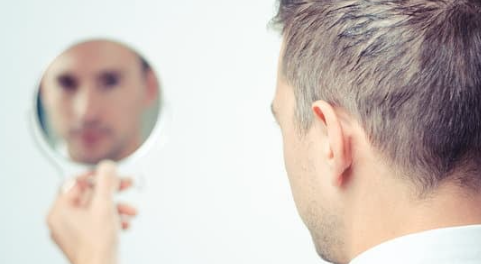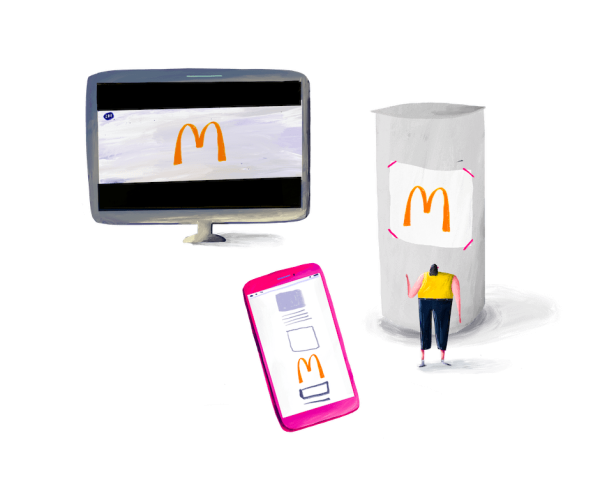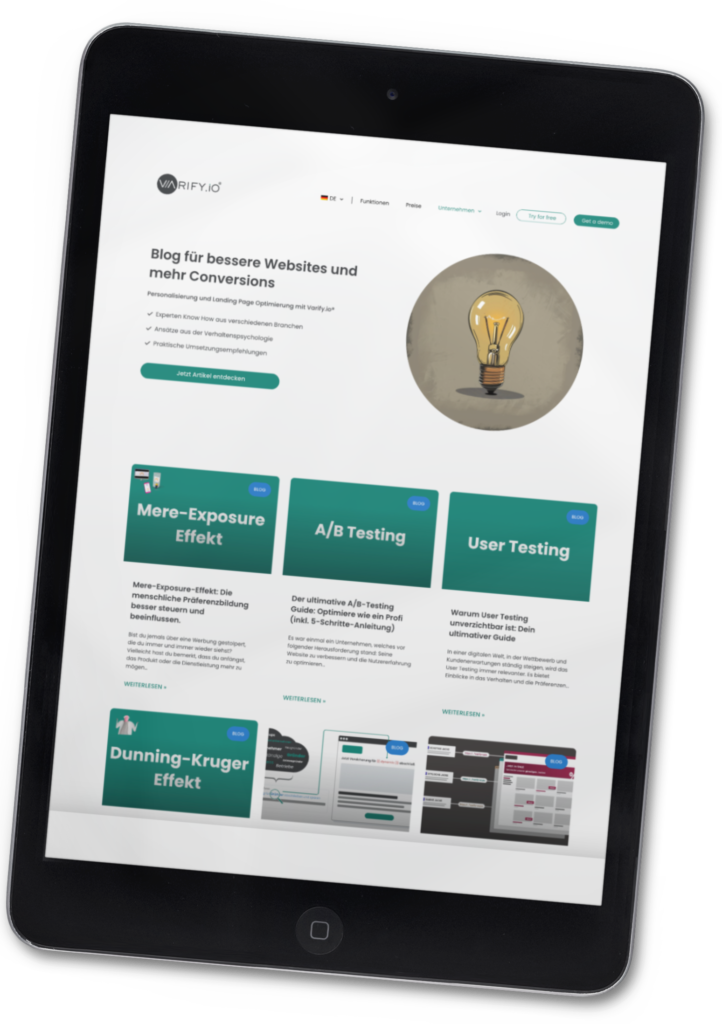
Do you remember the last time you had an earworm? At first you might not have even liked the song, but with each listen you grew to like it more and more.
Why is this happening?
The Mere exposure effect is the secret!
He shows how repetition influences our preferences and makes things seem more attractive to us.
In this article, you will find out how this psychological trick works, where it occurs and how you can use it cleverly in online marketing. Discover the fascinating power of repetition!

What is the Mere Exposure Effect?
The mere-exposure effect describes the phenomenon that people evaluate things that they encounter frequently more positively. This means that the more often we are exposed to a certain stimulus, such as a picture, a melody or a person, the more sympathetic we become to this stimulus. This effect occurs in many areas of our lives and often influences our behavior without us being aware of it.
The principle behind it is simple: The more often we see, hear or experience something, the more we like it.
Robert Zajonc, an important social psychologist, was the first to scientifically research and document the mere-exposure effect. In his studies, Zajonc showed that people evaluated complex Chinese characters more positively the more often they had seen them before, even if they did not understand the characters. His work laid the foundation for understanding this phenomenon and its far-reaching effects.
The mere-exposure effect usually works subconsciously. This means that we do not have to actively remember having encountered a stimulus in order to have a positive reaction to it. This subconscious preference occurs because our brain perceives familiar stimuli as safer and more pleasant without us being aware of it. This explains why we are often attracted to things we see or hear frequently without knowing exactly why.
The effect in a self-experiment: the mirror image example
Have you ever noticed that you find your own reflection more attractive than photos of yourself?
Try it out: First look at yourself in the mirror and then in a photo. You will probably like the mirror image better. This is because you see your reflection much more often and are therefore more familiar with it.
Your friends, on the other hand, see you as you look in photos and therefore prefer this view.
Our brain prefers the familiar - in this case our reflection in the mirror, which we see every day. Try it out and experience the effects of the mere-exposure effect first hand.

The mere-exposure effect in everyday life
Friends & contacts: The mere-exposure effect is clearly evident in friendships. People we see regularly, such as neighbors or colleagues, become more familiar and therefore more likeable. This explains why many friendships develop through shared activities or the workplace.
Partner: The effect also plays a major role when choosing a partner. People we meet regularly, such as colleagues or friends, appear more likeable and attractive to us. These frequent encounters can lead to romantic feelings developing, even if there was no particular attraction to begin with.
Nutrition & eating habits: The effect even influences our eating habits. Food that we see or try frequently becomes more familiar and tastes better to us. This is one of the reasons why we often reach for the same products in the supermarket and prefer familiar dishes.
The Mere Exposure Effect in Today's Marketing
In the world of advertising and marketing, the mere-exposure effect is a powerful tool. Companies use this effect to attract consumers to their products or services.
Simply put, the more a person is exposed to a particular brand or product, the more likely they are to favor that brand or product.
The impact of the mere-exposure effect can also be clearly felt in the digital marketing landscape...
Just think about the repeated ads you see on social media platforms or in your email. This strategy aims to familiarize you with the brand or product, which ultimately leads to a positive attitude and possibly a purchase decision.
A good example is Facebook ads, which show us the same products over and over again until we finally set our eyes on them.

Customer experience in connection with the mere-exposure effect
The mere-exposure effect plays a role not only in creating brand awareness and brand preference, but also in improving the customer experience.
The more customers come into contact with a product or service, the more trust they develop in it. The result? Higher customer loyalty and ultimately stronger business.
An example of this would be Amazon. The company strives to familiarize its customers with their services such as recommendations, personalized emails, and user-friendly navigation through repeated interactions. As a result, customers develop a deep trust in Amazon and return again and again.
Development & conditions of the mere-exposure effect
The mere-exposure effect unfolds in different contexts and with different stimuli - whether visual, through sounds or smells. Certain conditions should be taken into account to ensure that this effect is shown to its best advantage:
- Complex stimuli: The effect is stronger with complex stimuli. These hold our interest for longer and are therefore viewed more often.
- Delayed valuation: The positive evaluation of the stimulus should not take place immediately after the presentation in order to allow unconscious influence.
- Short performance time: Stimuli that are presented for less than a second achieve better results because they arouse interest without being overwhelming.
- Medium frequency: Around ten repetitions are ideal to achieve a positive effect without creating boredom.
- Lack of conscious memory: The effect is stronger if there is no conscious memory of the previous performance. This prevents a conscious evaluation and allows the unconscious preference to take effect.
By taking these conditions into account, the mere-exposure effect can be used specifically to build up positive associations and preferences. This shows how powerful and versatile this psychological effect is.
Examples from marketing: The effect in action
The mere-exposure effect unfolds in different contexts and with different stimuli - whether visual, through sounds or smells. Certain conditions should be taken into account to ensure that this effect is shown to its best advantage:
Commercials and slogans
Commercials and slogans
Recurring commercials and catchy slogans are an excellent example of the use of the mere-exposure effect. McDonald's slogan, "I love it", sticks in the mind through constant repetition and creates trust in the brand. Frequent repetition in various media channels makes the slogan familiar and positive.
Sport Sponsoring
Sport Sponsoring
Companies use sporting events to place their logos clearly visible in the stadium or on the jerseys of the athletes. This constant presence ensures that the brand is associated with positive emotions and experiences related to sport. Spectators who regularly see a particular logo develop an unconscious preference for the brand, which increases its recognition value and loyalty.
Politics
Politics
Social media
Social media
Songs
Songs
The mere-exposure effect unfolds in different contexts and with different stimuli - whether visual, through sounds or smells. Certain conditions should be taken into account to ensure that this effect is shown to its best advantage:
Practical tips for using the mere-exposure effect in online marketing
Want to harness the power of repetition in your online marketing? The mere-exposure effect can strengthen your brand and improve customer loyalty. Here are some effective strategies:
1. repeated displays
Use regular and targeted advertisements on various platforms. Frequent visibility increases the chances that your target group will notice the ads and react positively to them.
However, be careful to find a healthy balance to avoid advertising fatigue. For example, plan weekly rotations to maintain a balance between repetition and freshness.
2. social media presence
Build a strong presence on various social media channels and regularly post relevant content. Constant activity keeps your brand in the minds of users. Use different formats such as images, videos and stories to offer variety and increase the engagement rate. Regular interactions with your followers also strengthen the bond.
3. email marketing
Email marketing is an effective way to stay in regular contact with your customers. Send well-designed newsletters that contain valuable information and offers. Personalize the emails based on the preferences and behavior of the recipients to capture their attention and generate long-term interest. A consistent frequency, for example weekly or monthly, helps to keep your brand present.
4. content marketing
Create and share high-quality content that is tailored to the interests and needs of your target group. Guides, blog articles, videos and infographics can be used to provide valuable information and build trust. Publishing regularly on your website and promoting it via social media will ensure that your brand is perceived as a trustworthy source.
5. consistent brand message
Keep your brand message consistent across all channels. Consistent branding that is coherent both visually and in terms of content strengthens the trust and recognition of your brand. Develop clear guidelines for communication and ensure that these are implemented in all marketing measures.
Conclusion
The mere-exposure effect is a fascinating psychological phenomenon that shows how strongly repetition influences our preferences and decisions.
Whether in advertising, on social media or in personal relationships - frequent visibility and repeated encounters create familiarity and sympathy. By making targeted use of this effect, brands can build trust, strengthen customer loyalty and ultimately be more successful.
By understanding and applying the principles of the Mere Exposure Effect, we can act more consciously and strategically, not only in marketing but also in everyday life.
